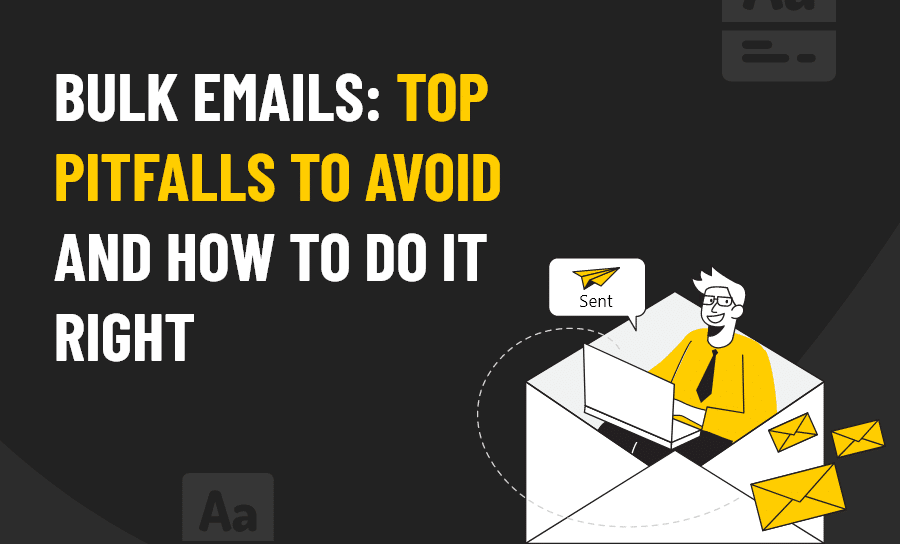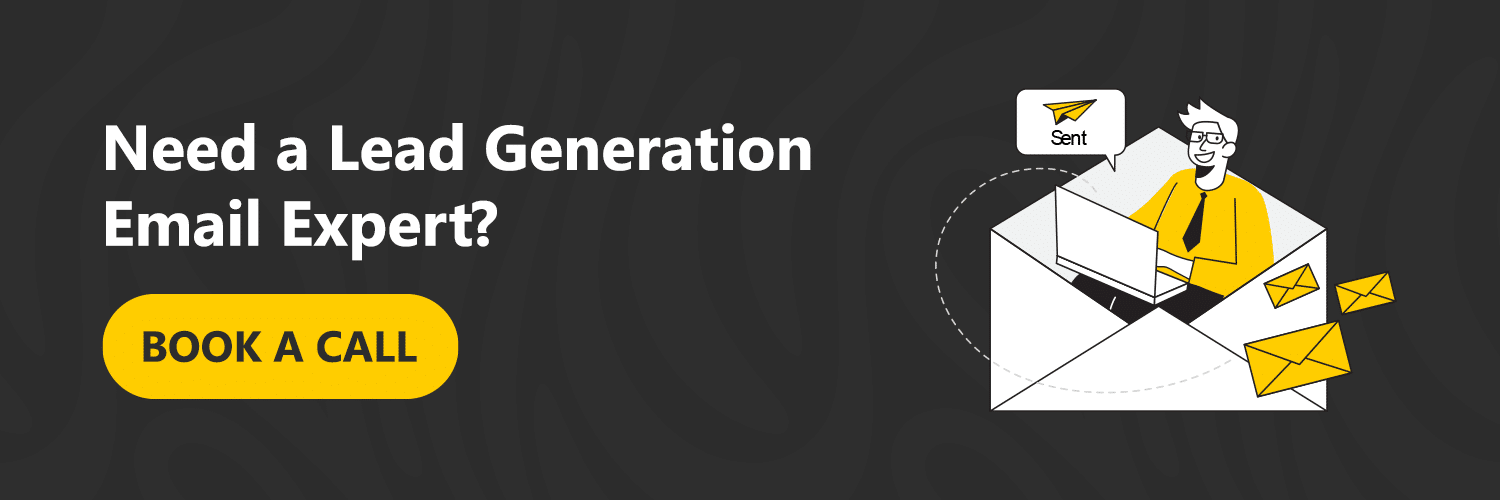Bulk emails are used to describe emails sent to a large number of people. While email blasting all the subscribers on your subscriber list can be appealing and is frequently cost-effective, this method is usually received with lukewarm engagement and can actually harm your email program’s overall success. That’s why, whether you’re sending an email to one person or 100,000 people, you should always send thoughtfully and responsibly.
Now, we’re not suggesting you should never send mass emails; rather, you should use them sparingly and strategically. We work with a wide range of firms that send thousands of emails per month at Pearl Lemon Leads, so we’ve seen bulk email both fall short of expectations and be handled successfully and intelligently.
We’ve compiled some of our best practices and suggestions for scaling your email program to ensure your bulk email campaigns fall into the latter category.
In this guide, we’ll explain what bulk email is, how to send it effectively, and how to avoid typical pitfalls when sending large amounts of people the same email.
What is Bulk Email?
Bulk email, often known as mass email, is an email message sent to a large number of people at once. Sending a message to all or a portion of your subscribers can be a quick and efficient way to get the word out about breaking news or time-sensitive upgrades that affect your company and customers. With the correct level of personalization, it can also sometimes be used to send a marketing message based around a special event, sale or other theme.
How Does Bulk Email Differ From Other Forms of Email?
Transactional emails are sent to only one person in response to a single user’s behavior. This may be an email about an abandoned cart or a receipt with information about their most recent transaction. Bulk email, on the other hand, is also known as one-to-many email because it is sent from your company to a large number of people.
It’s crucial to distinguish bulk email from junk mail, which is sent without the permission of the recipient. Because subscribers have opted-in to receive messages from your brand and GDPR or CAN-SPAM criteria have been satisfied, sending mass email is acceptable. However, most bulk mail is referred to as graymail because of a lack of email targeting and message relevance.
Graymail is email that your receivers have agreed to get but do not necessarily really want to receive in their inboxes. Graymail isn’t considered spam because your recipients have opted in to receive communications from you, and your company is a legitimate sender. However, there will almost certainly be a gap in how valuable your email content is to your recipients. Recipient A, for example, might be overjoyed to receive your company’s monthly newsletter in their inbox, whereas Recipient B, who simply signed up for a coupon code, will delete it without even opening it.
While it’s an appealing idea to send an email blitz to your whole database, it’s rare that everyone wants to hear from you in the same way and at the same frequency. Rather than sending messages to the entire database, employ advanced segmentation to deliver messages to specific people on your list.
Doing this will help increase the chances that only people who are interested in this type of information see your email, boost open rates and interaction, reduce spam complaints, and, most importantly, help ensure that your audience continues to open and read your email messages in the future.
What Will Happen If You Send Too Much Bulk Email?
One of the biggest mistakes businesses make with bulk email is sending too much of it. Sending too many unwanted or uninteresting emails can harm your sender reputation as well as your subscribers’ relationship with your business. While an email blast has its place, we recommend that you educate yourself on the impact that too many non-targeted emails can have on your email marketing.
Here’s a closer look at the potential consequences of sending too many unwanted bulk emails:
Your Sender Reputation Will Suffer
Your IP address(es) or domain(s) may be blacklisted by internet service providers if they see a sudden spike in email volume. Your emails may be completely blocked by the ISP or filtered into your recipients’ spam folders if they are blacklisted. Fortunately, utilizing properly acquired email lists, reducing spam complaints, and gradually expanding send volume over time can all help your company maintain its reputation for integrity with your chosen email provider.
Your Bulk Email Engagement Rate Will Decrease
Your recipients may not want to engage with your messages if you send them too many unpersonalized and unrelated emails. As a result, engagement metrics like open rate and click-through rate will suffer. While tinkering with subject line copy, sender name, and send time can assist in improving open rates, your engagement will remain stagnant if your email content continues to disappoint subscribers.
More of Your Emails Will Be Marked as Spam
If you send a high volume of bulk email filled with uninteresting or uninvited content, your recipients are more likely to designate your emails as spam. ISPs may begin blocking your messages if you receive enough spam complaints, which means that even people who do wish to receive your messages will be unable to do so.
Your List Unsubscribe Rate Will Increase
Finally, if your subscribers do not value your messages, they will unsubscribe. Losing subscribers will have a negative impact on your email KPIs as well as your ability to accomplish business objectives.
While subscribers come and go, you should strive for an unsubscribe rate of less than 1% and work to expand your email list with every (targeted) email ‘blast’ you send.
How To Send Better Bulk Email
At Pearl Lemon Leads, we have a lot of experience and expertise when it comes to email marketing at scale. This has given us a lot of real world insight into what works, what does not work and how a bad mass email marketing strategy can be turned around and transformed into bulk email that CAN reach your target audience effectively and get the results you hoped for.
With all of this in mind, here are some of our top tips for doing just that:
Make Use of Email Preference Lists
Some people don’t mind more frequent emails, some will hit that delete/spam button in an instant if they get more than one a week. But how can you tell who is who? The answer is actually very simple: ask them.
Create an email preference center so that when someone signs up for your email list, they can choose whether or not they want to receive various types of information. For example, if someone just wants to know when you have deals, they may not want to receive your monthly newsletter or weekly marketing emails.
They can decide which of these emails they receive from the preference center, allowing you to send more focused emails without bothering your recipients. This will save you time and effort too, as you will spend far less time segmenting your email lists as those signing up will basically be ‘sorting’ themselves into appropriate audiences.
Always Make Sure You Have Send Permission
We don’t want to sound like a broken record, but be sure you’re collecting subscribers ethically and that each person on your list has given you clear permission to email them.
This is just one of the reasons that buying bulk email lists is never a good move. None of the names on those lists have given YOU specific permission to email them, so the vast majority are likely to either ignore your messaging or mark it as spam.
Cold email (emails sent to those who have not opted into an email list) can be very effective, especially for lead generation, but it’s a different art form (one Pearl Lemon Leads is very good at by the way) and is never approached in the form of big bulk email campaigns. If you want to learn more about cold emailing, you can start doing so here.
Practice Good Email List Hygiene
Remove dormant, bounced, and other non-engaged email addresses from your email list on a regular basis. Good email list hygiene will help you to improve your sender reputation, increase engagement rates, and decrease the likelihood of being placed on an email block list.
Consider “sunsetting” subscribers from your lists by limiting the quantity of emails they receive or removing them entirely if they haven’t interacted with your emails after a certain amount of time. This can help you enhance your overall engagement rates, reduce the amount of spam traps your messages are sent to, and reduce spam complaint rates.
Don't Send Bulk Email Too Often
Even if you are making use of all the bulk email best practices we’ve covered here already, resist the temptation to go overboard with bulk email blasts. According to industry research, more than 60% of email subscribers will consider unsubscribing even from lists they do interact with if they receive email daily.
Take the time to monitor your bulk email campaigns and re-segment your lists based on engagement.
Leverage Re-engagement for Bulk Emails
Unengaged audiences can affect your email program’s performance, but before you delete your inactive subscribers, try re-engaging them with a re-engagement campaign.
Begin by compiling a list of subscribers who haven’t read one of your emails in a given amount of time—ideally one to two months—and then asking them directly if they still want to receive your emails. Give your readers two explicit opportunities to opt-in or out of future communications in the body of your email, so you may proactively remove disengaged email addresses.
Take those who re-subscribe to your list to your email preference center so they can choose how often they want to hear from you.
faqs
Bulk email marketing is an all-encompassing term that refers to any email marketing technique that targets a large group of people rather than individual recipients. An email newsletter is an excellent example of bulk email marketing, as newsletters are meant to broadcast information and updates about your brand to as many people as possible. Whereas the goal of individually targeted emails is to react to a specific action that one user has taken, bulk emails allow you to reach a large audience based on a simple action they’ve all taken.
Here are some things you can do to avoid getting your bulk emails blacklisted:
- Choose the right provider – If you’re using a bulk email service to send out bulk emails, you’ve got the right idea! Using a bulk email service provider will help you a great deal in saving time and money when sending out your bulk emails. However, ensure you’re using a reputable source with a reliable IP address. Otherwise, email providers like Gmail will mark your emails as spam.
- Let your recipients unsubscribe – Always include a noticeable option to unsubscribe from your emails. This will signal to the email provider that you’re not trying to spam people with emails who don’t want them. Remember: it’s better to lose some subscribers through the unsubscribe button than to lose all of them through a spam filter.
- Always ask permission – Make sure your recipients opt-in to your emails before sending them out. Your customers’ consent will go a long way towards proving yourself to the spam filter.
Bulk email is pretty much anything with a large group of recipients instead of just one or a couple. You can find several uses in your marketing strategy for an extensive email list (and many companies have!) You can send promotional emails that give customers access to discounts and other offers on your ecommerce platform, newsletters that keep your audience updated on your brand and product lines, or retention emails that give special offers to users who aren’t opening your emails.
Email marketing, all around, is a challenging digital marketing art to master. It can be difficult to know the right audience or the precise time when you should send your emails. Even if you know these things right away, it can be difficult to make your emails stand out from the hundreds (or potentially thousands) of emails your customers receive daily.
These challenges have led many companies to utilise a lead generation service like Pearl Lemon Leads. The great thing about lead generation services is that they handle all aspects of your bulk email campaign and use their industry knowledge to send out emails to your client base. This will generate loads of leads while saving your business time and money.
To send a bulk email marketing campaign, just follow these simple steps:
- Connect your email account to your bulk email service provider.
- Make a clean email list of recipients. A great way to do this is to create a list of your recipients in a spreadsheet creator like Excel or Google Sheets and then export the list as a CSV file, as this is the format that most bulk email services will accept.
- Start drafting your email sequence. Write your email using less than 125 words, and don’t include too many links or spam words.
- Upload your email list. Your bulk email service will typically accept a CSV file of your recipient list and sort those based on the column headers you created in your original sheet.
- Click send or schedule a later time to deliver your message to the masses!







